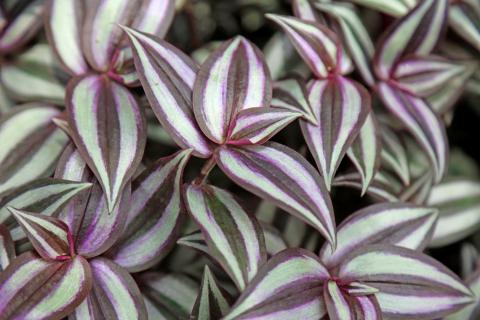Tradescantia zebrina or inch plant is a type of spiderwort known for its attractive purple- and silver-striped foliage. This houseplant knows how to survive any indoor environment and perfect for the wanna-be-green thumb! Here’s how to care for an inch plant in your home.
About Tradescantia or Inch Plant
Tradescantia zebrina (pronounced trad-es-KAN-tee-uh zeb-REE-nuh), formerly Zebrina pendula, is a species of creeping plant in the Tradescantia genus. Common names include inch plant and wandering Jew. The latter name is controversial, and some now use the alternative wandering dude. Another common name is Variegated Spiderwort.
While Tradescantia zebrina is a perennial plant in its native Mexico, its treated as a houseplant in North America, and commonly grown in a hanging pot. It is considered invasive species in warm regions outside of their home ranges (including in parts of the southeastern U.S.). For this reason, we recommend growing inch plants indoors or keeping them restricted to containers outdoors.
Not only does the inch plant have attractive leaves but it’s fast-growing, with trailing stems. Leaf nodes on the stem are supposed to be 1-inch apart, hence the common name inch plant. Each segment is capable of producing a new plant so Tradescantia is easily started from cuttings which root readily in moist soil.

- Grow in all-purpose indoor potting mix in either a pot or hanging basket.
- Select a location with filtered sun. Keep inch plants out of direct sunlight and out of dark areas, which will cause them to become leggy.
- The room temperature should be average (between 55° and 75°F).
- Water deeply, but allow the soil to dry partially before watering again. This plant doesn’t like to dry out, but it also doesn’t like to be constantly wet.
- Water less during the winter months, which is the plant’s resting period.
- Provide fertilizer twice a month in the spring and summer; don’t fertilize in fall and winter.
- Pinch back to keep this trailing plant contained as well as promoting bushier foliage.
- Removed leggy growth also allows for cuttings that can be used for propagation.
- Plants can be pruned back hard every spring and can be taken outside on a protected patio in the summer.
- No serious insect or disease problems.
- Aphids tend to be a problem on the stems and leaves. Monitor for aphids (and other small insects) as they could become an issue if unchecked. To get rid of them, pinch off the infected stems and spray the plant with water.
- Root rot and stem rot can occur in soggy soil.
- Note that contact with plant sap causes skin irritations in some individuals.
- Tradescantia zebrina ‘Tricolor’ (pictured at the top of this page) has beautiful purple and green leaves with shiny silver stripes.
- Tradescantia pallida ‘Purple Heart’ has fuzzy, purple foliage.
- Tradescantia fluminensis ‘Quicksilver’ has variegated white-green foliage.
- Inch plants can easily be propagated by cuttings. Snip off a piece of the plant (the cutting should ideally be 3–4 inches long) and place the cut end in water. In about a week (or less), the cutting should produce roots. A week or so after that, plant the cutting in a pot according to the planting guidelines above.




